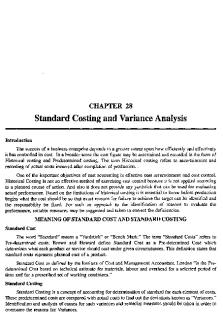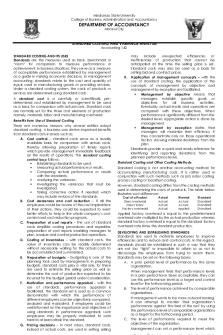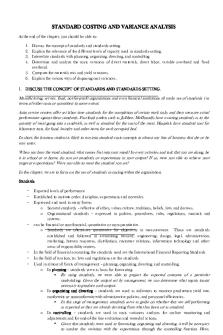Variance Analysis Essay PDF

| Title | Variance Analysis Essay |
|---|---|
| Course | Health Care Accounting and Billing |
| Institution | Grand Canyon University |
| Pages | 6 |
| File Size | 115.3 KB |
| File Type | |
| Total Downloads | 16 |
| Total Views | 132 |
Summary
Variance Analysis Essay...
Description
Running Head: VARIANCE ANALYSIS
Variance Analysis Essay
Patricia Revelles Grand Canyon University: HCA-240 September 15th, 2020 Professor Joseph Anderson
1
2
VARIANCE ANALYSIS
Introduction Today, the healthcare industry can be recognized for its quickly developing and complex health network. Healthcare services and medical technology have become the fastest-growing profit pool in the healthcare industry over the past ten years. This is essentially due to a trend driven by significant technology-based and enabled innovations. Most healthcare services and medical technology companies have focused on managing medical costs and quality by increasing effectiveness, performance, and efficiency taking place within administrative functions. Healthcare managers play a significant role in administering within a variety of healthcare facilities. Hospital manager positions include titles such as hospital administrators, patient care managers, and practice managers. These professionals typically manage an entire healthcare facility, a medical practice group of physicians, or a specific clinical area or department such as finance, or patient care services (Walsh K. 2016). In general, hospital healthcare managers juggle several responsibilities. They carry the duty of supervising all areas of a hospital including, practitioners, health information technicians, nursing, medical records, and more (Lazariu, V., & McLaughlin, C. C. 2019). Because these professionals work in a variety of hospital settings, ranging from human resources to specialized clinical areas, they must collaborate across disciplines, manage an organization’s budget and finances, and lead talent development. Health care managers quickly become familiar with the process of creating many reports to analyze the effectiveness of various departments and work to reach financial goals and maintain budgets. A health manager ultimately strives to coordinate a variety of stakeholders and guide them to focus on a common goal. These administrators may also drive innovation in hospital processes and see tangible results in inpatient care. In the end, accountability impacts innovation in that managers have to demonstrate effectiveness, safety, and other regulatory principles to accrediting organizations.
3
VARIANCE ANALYSIS
Factors That Should be Considered When Writing a Variance Report to Your Vice President Almost every health care facility in the United States uses variance reports and analysis to explain variation between planned and actual costs and charges. A variance report does the job of measuring the differences between expected results and actual results of a production process or other business activity. Moreover, variance reporting is a process used to identify the causes of variation in the income and expenses of the current year from the budgeted costs. Examining and measuring variances can help management contain and control expenses and improve operational efficiency (Kao, L. S., Lally, K. P., & Tsao, K. 2019). This type of analysis is becoming highly common and used due to healthcare executives working to improve efficiency within the hospital. Assorting usage also includes to set priorities for organizational improvement and to explain costs and charges to interested groups such as purchasers and payers. This kind of reporting even aids many administrative professionals in understanding why fluctuations took place and what should be done to reduce the unfavorable variance. Variance reports eventually help in better budgeting activity within the healthcare organizations. Variance reports produce data that must be presented in a format useful and comprehendible to senior executives such as vice presidents. An effective format would help in displaying the data in a visual review that is simple enough to be clearly understood and detailed enough to provide valuable information. When writing, developing, and presenting a variance report to the health organization's vice president, healthcare managers must write detailed variance reports that include all possibilities that have the potential of playing out. Factors that should be taken into consideration when formulating these reports is to keep in check the reliability and accuracy of the figures being presented, track prices incurred to purchase supplies, the amount of time health workers are investing into the workplace, the cost of labor by health
4
VARIANCE ANALYSIS workers per hour, and the inherent variability of the cost or revenue (Bojke, C., & Walshe, K. 2018).With the help of efficient variance reporting, hospitals can then spot problematic inclinations, issues, opportunities, and threats to short-term or long-term success.
The Relationships Between Interpreting Operational Variance Report Budget Goals and Actual Results of Performance Variance analysis ranges from simple and straightforward to sophisticated and elaborate. The most advanced systems carry the duty of separating unit and price factors. These factors specifically come from medical material, worked hours, cost-per-hour directly related to labor, and fixed or shifting overhead variances. Variance reports examine the effects of what caused a difference between what was planned vs. what happened. These reports then become summarized and presented as an analysis of the difference between planned and actual numbers (Provost, L., & Bergman, B. 2011). The total amount of all variances helps in giving health managers a picture of the overall over-performance or under-performance for a particular reporting period. For each item, healthcare organizations assess their favorability by comparing actual costs and standard costs in the industry. When standards are associated with actual performance figures, the difference is what is labeled as the variance. Now, when it comes to comparing the relationships between interpreting operational variance report budget goals and actual results of performance, there are specific variables that differ from each other. Variances are always computed and reported to management. Within these reports, both the price and quantity of needed medical supplies and labor hours are recorded. However, not all variances are critically required. Healthcare managers should only be paying close attention to variances that are unusual or especially significant. Variance analysis is vital to good management within any healthcare organization.
VARIANCE ANALYSIS
5
Describing the Variance Issues to be Addressed in Accordance With Health Care Organizations (HCO) That Require Justification Healthcare managers handle variation differently to achieve different needed outcomes. Health care managers are primarily concerned with the performance of care processes over time. Their goal is to create processes that are stable and effective. Because variance analysis is defined as the quantitative investigation of the difference between real and planned performance, this analysis is then used to maintain control throughout the healthcare facility. However, there are several problems with variance analysis that keep many health care companies and organizations from using it. A healthcare organization (HCO) is defined as a purposefully designed, structured social system developed for the delivery of health care services by specialized workforces to defined communities, populations, or markets (Provost, L., & Bergman, B. 2011). Some major variance issues that need to be addressed under Health Care Organizations (HCO) are time delays, variance source information, and standard-setting limitations. Variance analysis can be primarily recognized for being a comparison of actual results to an unreasonable standard that may have been taken from legislative bargaining. It comes to no surprise how the resulting variance may not gain or generate any beneficial information. Furthermore, many Health Care Organizations prefer to use horizontal analysis rather than variance analysis. This method is used to investigate and interpret their financial results. Still, variance reporting is highly recognized for helping to reduce medical errors, better patient-centered care, and improve overall healthcare operations within medical institutions.
6
VARIANCE ANALYSIS
References Akinleye, D. D., McNutt, L. A., Lazariu, V., & McLaughlin, C. C. (2019). Correlation between hospital finances and quality and safety of patient care. PloS one , 14( 8), e0219124. https://doi.org/10.1371/journal.pone.0219124
Gutacker, N., Bloor, K., Bojke, C., & Walshe, K. (2018). Should interventions to reduce variation in care quality target doctors or hospitals?. Health policy , 122( 6), 660–667. https://doi.org/10.1016/j. healthpol.2018.04.004
Kawaguchi, A. L., Jain, R., Hebballi, N. B., Pham, D. H., Putnam, L. R., Kao, L. S., Lally, K. P., & Tsao, K. (2019). Using a Second Stakeholder-Driven Variance Reporting System Improves Pediatric Perioperative Safety. Pediatric quality & safety , 4( 5), e220. https://doi.org/10.1097/pq9.00000 00000000220
Neuhauser, D., Provost, L., & Bergman, B. (2011). The meaning of variation to healthcare managers, clinical and health-services researchers, and individual patients. BMJ quality & safety , 20 Suppl 1 ( Suppl_1), i36–i40. https://doi.org/10.1136/bmjqs.2010.046334
Walsh K. (2016). Managing a Budget in Healthcare Professional Education. Annals of medical and health sciences research , 6( 2), 71–73. https://doi.org/10.4103/ 2141-9248.181841...
Similar Free PDFs

Variance Analysis Essay
- 6 Pages

Variance analysis
- 21 Pages

Variance Analysis - Grade: A
- 5 Pages

Analysis of Variance
- 7 Pages

Two-Way Analysis of Variance
- 5 Pages

Standard-costs-and-variance-analysis
- 14 Pages
Popular Institutions
- Tinajero National High School - Annex
- Politeknik Caltex Riau
- Yokohama City University
- SGT University
- University of Al-Qadisiyah
- Divine Word College of Vigan
- Techniek College Rotterdam
- Universidade de Santiago
- Universiti Teknologi MARA Cawangan Johor Kampus Pasir Gudang
- Poltekkes Kemenkes Yogyakarta
- Baguio City National High School
- Colegio san marcos
- preparatoria uno
- Centro de Bachillerato Tecnológico Industrial y de Servicios No. 107
- Dalian Maritime University
- Quang Trung Secondary School
- Colegio Tecnológico en Informática
- Corporación Regional de Educación Superior
- Grupo CEDVA
- Dar Al Uloom University
- Centro de Estudios Preuniversitarios de la Universidad Nacional de Ingeniería
- 上智大学
- Aakash International School, Nuna Majara
- San Felipe Neri Catholic School
- Kang Chiao International School - New Taipei City
- Misamis Occidental National High School
- Institución Educativa Escuela Normal Juan Ladrilleros
- Kolehiyo ng Pantukan
- Batanes State College
- Instituto Continental
- Sekolah Menengah Kejuruan Kesehatan Kaltara (Tarakan)
- Colegio de La Inmaculada Concepcion - Cebu









